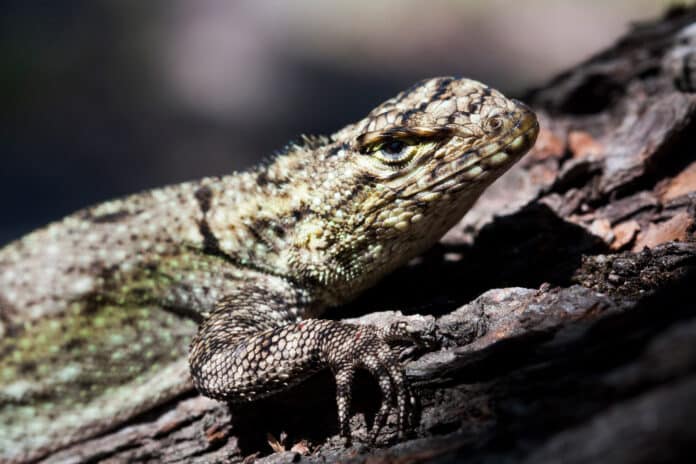Social and behavioral activities, including moving about the environment in search of potential partners, putting on displays to assert dominance, and courtship behaviors, are frequently shaped by sexual selection. Increased temperatures, especially among ectotherms, might have a negative impact on these activities since people would either have to put up with uncomfortable conditions or devote more time to thermoregulation by being more prone to finding shelter. They thereby “miss” chances for social and reproductive interaction.
To understand how high temperatures affect mate choice, a recent study compared the daily patterns of social interactions in Tropidurus spinulosus, an ectotherm model, in two thermally distinct environments.
The Tropiduridae family, which contains many social lizard species, includes Tropidurus spinulosus. Individuals interact in groups on rocky outcrops, especially in T. spinulosus.
Scientists employed a space-for-time substitution approach to examine a species in habitats that differ in environmental parameters, such as temperature, to the extent that it models a global warming forecast. Using dataloggers, scientists measured the substrate temperature (Ts) in habitats with HIGH and LOW temperatures to describe the thermal environment. Throughout the investigation, dataloggers continuously recorded the instantaneous temperature at 5-minute intervals.
First, samples were taken from the tallest perch position and a perch location of medium height in each rocky outcrop where the angle of sun incidence varied. However, the temperature readings were averaged because Ts did not significantly differ between the two perches.
Ts was also taken as a reliable estimation of the species’ operative temperature (Te) since the thermal biology of small reptiles is roughly estimated by a “naked datalogger.”
Researchers used camera trap recordings to describe the activity pattern in both HIGH and LOW thermal environments. The cameras were set on stakes 5 meters away from the rocks to minimize disturbing animal behavior.
Tropidurus spinulosus behaved differently in its natural habitat under two distinct heat conditions, as was expected. The hourly adjustment of time spent moving and time spent among conspecifics varied between lizards from the two thermal habitats.
Scientists noted, “However, the total active time, total movement time, and the temporal pattern of Pushups were similar in both habitats. Therefore, our predictions were partially corroborated since the hourly and daily social and behavioral patterns varied (unimodal in the LOW-temperature habitat and bimodal in the HIGH-temperature habitat). Still, the total daily activity time did not.”
Because they spent more time inside the thermal refuges, males allocated less time to interact with conspecifics in the highest temperature treatment than in the lowest one regarding sexual interactions. Females also demonstrated this trend, though it was only marginally significant.
The results of the selection process and the Headbobs pattern for both sexes were likewise altered by high temperatures. The study is the first to show a decrease in the amount of time given to choosing a mate and a modification of the selection outcome as a result of rising temperatures.
Scientists noted, “Increasing temperatures are likely to reduce the width of the operational thermal window in lizards. However, understanding how lizards react to changing temperatures requires the study of the pattern of behavioral changes.”
“Although we found no differences in total activity time between habitats, the behavioral activity pattern varied since the overlap between HIGH and LOW-temperature habitats was low according to the criteria proposed.”
The change from a unimodal to a bimodal pattern demonstrates that lizards can plastically alter their behavior along a temporal axis, perhaps due to other behavioral possibilities like changing their posture.
This result is consistent with the “medium constraint” theoretical models’ predictions that restricted activity occurs inside the Tset bounds at high temperatures. These limitations may eventually compel a species to favor one action over another. These limitations may eventually compel a species to favor one action over another.
Scientists noted, “However, the activity pattern we recorded is just one dimension of activity, and to get a more comprehensive picture of the species plasticity, further research should address other relevant aspects of the activity about temperature, such as probability, mode, and vigor/physical exertion.”
In conclusion, increasing temperatures may modify the behavioral activity pattern since lizards shift from a unimodal to a bimodal daily pattern. Social behavior could also be impacted since individuals adjust interactions to operative temperatures close to their preferred range. However, lizards might sometimes move between perch positions and interact outside this range.
Furthermore, high temperatures also affect mate choice dynamics since males and females spend less time interacting with possible partners, thus missing opportunities. Moreover, the selection outcome may become increasingly random, leading to different reproductive strategies to cope with thermal stress.
Journal Reference:
- Rossi N, Chiaraviglio M, Cardozo G (2023) Behavioural plasticity in activity and sexual interactions in a social lizard at high environmental temperatures. PLoS ONE 18(7): e0285656. DOI: 10.1371/journal.pone.0285656
